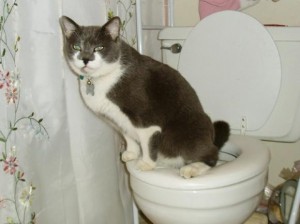The Dangers of Flushing Cat Poop Down Your Toilet - Advice for Better Disposal
The Dangers of Flushing Cat Poop Down Your Toilet - Advice for Better Disposal
Blog Article
Just about every person has got his or her own thinking involving How to Dispose of Cat Poop and Litter Without Plastic Bags.

Intro
As feline owners, it's vital to be mindful of how we dispose of our feline friends' waste. While it may appear practical to flush feline poop down the commode, this method can have detrimental repercussions for both the environment and human health and wellness.
Environmental Impact
Purging cat poop presents unsafe virus and bloodsuckers right into the water system, presenting a considerable risk to water ecosystems. These pollutants can adversely affect marine life and concession water quality.
Health Risks
In addition to ecological issues, purging feline waste can additionally pose wellness risks to people. Pet cat feces might consist of Toxoplasma gondii, a bloodsucker that can cause toxoplasmosis-- a potentially severe health problem, especially for expectant ladies and people with weakened immune systems.
Alternatives to Flushing
Fortunately, there are safer and much more accountable methods to take care of feline poop. Take into consideration the adhering to options:
1. Scoop and Dispose in Trash
The most usual approach of dealing with pet cat poop is to scoop it right into a biodegradable bag and toss it in the trash. Be sure to use a committed litter scoop and take care of the waste quickly.
2. Usage Biodegradable Litter
Opt for naturally degradable feline clutter made from materials such as corn or wheat. These trashes are environmentally friendly and can be securely disposed of in the trash.
3. Bury in the Yard
If you have a yard, think about burying pet cat waste in a marked location far from vegetable yards and water sources. Make sure to dig deep sufficient to stop contamination of groundwater.
4. Set Up a Pet Waste Disposal System
Invest in a pet waste disposal system particularly developed for pet cat waste. These systems utilize enzymes to break down the waste, reducing smell and environmental effect.
Final thought
Responsible pet dog possession extends beyond offering food and sanctuary-- it also includes appropriate waste monitoring. By refraining from purging pet cat poop down the toilet and choosing different disposal techniques, we can lessen our environmental impact and protect human health.
Why Can’t I Flush Cat Poop?
It Spreads a Parasite
Cats are frequently infected with a parasite called toxoplasma gondii. The parasite causes an infection called toxoplasmosis. It is usually harmless to cats. The parasite only uses cat poop as a host for its eggs. Otherwise, the cat’s immune system usually keeps the infection at low enough levels to maintain its own health. But it does not stop the develop of eggs. These eggs are tiny and surprisingly tough. They may survive for a year before they begin to grow. But that’s the problem.
Our wastewater system is not designed to deal with toxoplasmosis eggs. Instead, most eggs will flush from your toilet into sewers and wastewater management plants. After the sewage is treated for many other harmful things in it, it is typically released into local rivers, lakes, or oceans. Here, the toxoplasmosis eggs can find new hosts, including starfish, crabs, otters, and many other wildlife. For many, this is a significant risk to their health. Toxoplasmosis can also end up infecting water sources that are important for agriculture, which means our deer, pigs, and sheep can get infected too.
Is There Risk to Humans?
There can be a risk to human life from flushing cat poop down the toilet. If you do so, the parasites from your cat’s poop can end up in shellfish, game animals, or livestock. If this meat is then served raw or undercooked, the people who eat it can get sick.
In fact, according to the CDC, 40 million people in the United States are infected with toxoplasma gondii. They get it from exposure to infected seafood, or from some kind of cat poop contamination, like drinking from a stream that is contaminated or touching anything that has come into contact with cat poop. That includes just cleaning a cat litter box.
Most people who get infected with these parasites will not develop any symptoms. However, for pregnant women or for those with compromised immune systems, the parasite can cause severe health problems.
How to Handle Cat Poop
The best way to handle cat poop is actually to clean the box more often. The eggs that the parasite sheds will not become active until one to five days after the cat poops. That means that if you clean daily, you’re much less likely to come into direct contact with infectious eggs.
That said, always dispose of cat poop in the garbage and not down the toilet. Wash your hands before and after you clean the litter box, and bring the bag of poop right outside to your garbage bins.
https://trenchlesssolutionsusa.com/why-cant-i-flush-cat-poop/

I'm very eager about How to Dispose of Cat Poop and Litter Without Plastic Bags and I hope you liked the article. Sharing is good. You won't know, you might be doing someone a favor. I value reading our article about How to Dispose of Cat Poop and Litter Without Plastic Bags.
Additional Information Report this page